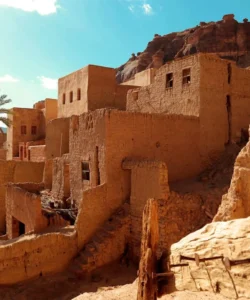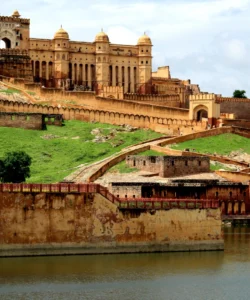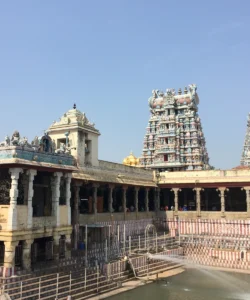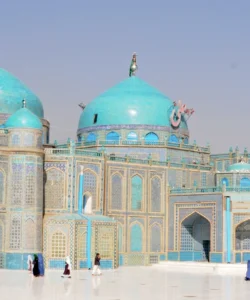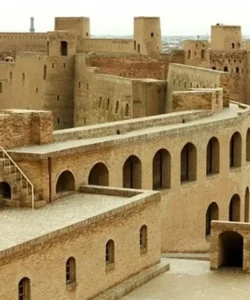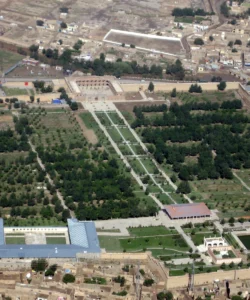The Minaret and Archaeological Remains of Jam are an extraordinary archaeological site located in a remote and rugged valley in western Afghanistan. Its centerpiece, the Minaret of Jam, is a towering monument that serves as a testament to the power and artistic sophistication of the Ghurid dynasty, a short-lived but influential Islamic empire that dominated the region in the 12th and 13th centuries.
Name: Minaret and Archaeological Remains of Jam (Pashto: د جام منار, Dari: منار جام; also known as the Minaret of Jam)
Address: Shahrak District, Ghor Province, Afghanistan. The minaret is situated in a rugged and nearly inaccessible valley at the confluence of the Hari and Jam rivers, approximately 215 kilometers east of Herat.
How to Get There:
Access to the Minaret of Jam is extremely difficult and dangerous due to its remote location and the political instability in Afghanistan. It is not a site that is safely or easily accessible to general tourism. The following information is for historical context and is not a recommendation for travel.
- By Air: The closest major airport would be Herat International Airport (HEA), but onward travel is arduous and unsafe.
- By Road: The journey from a major city like Herat or Kabul would involve days of difficult, off-road driving through a rugged and often unpaved mountainous region, which is currently considered a security risk.
- Organized Tours: Prior to the recent political changes, a few specialized tour operators organized expeditions, often taking several days, to reach the minaret. However, this is no longer a viable option for international visitors.
- UNESCO efforts: UNESCO has made efforts to work with local communities for its preservation and has provided some funding.
Landscape and Architecture:
The Minaret and Archaeological Remains of Jam are a stunning example of Islamic architecture, built in a remote and dramatic natural setting.
- Sleek Tapering Minaret: The centerpiece is the 65-meter (213-foot) high minaret, a graceful and soaring cylindrical structure. It is built in four tapering superimposed shafts, giving it an elegant and slender silhouette. The minaret rests on a solid, octagonal base.
- Elaborate Brickwork and Calligraphy: The entire minaret is constructed from baked bricks and is meticulously covered in intricate geometric patterns, Kufic and Naskh inscriptions, and floral motifs. The brickwork is so sophisticated and detailed that it has been described as “lace-like,” creating a mesmerizing interplay of light and shadow. A continuous band of Quranic verses, including the entire Surah Maryam, is inscribed in stucco and terracotta, which is also a very prominent feature. One band features turquoise tiles, adding a splash of color to the monochromatic brick.
- Architectural Protoype: The minaret’s design and ornamentation are considered a culmination of an architectural tradition in Central Asia and a direct inspiration for the Qutub Minar in Delhi, India, which was built shortly after the Ghurid conquest of northern India. The Qutub Minar’s resemblance to the Minaret of Jam is a testament to the latter’s influence.
- Lost City of Firuzkuh: The minaret is believed to be the only surviving monument of Firuzkuh, the legendary summer capital of the Ghurid dynasty. The city was almost completely destroyed by Genghis Khan’s Mongol invasion in the early 13th century, and its remains are buried and scattered across the valley. The minaret stands alone, a poignant reminder of a lost civilization.
- Confluence of Rivers: The minaret is located at the confluence of the Hari Rud and Jam Rud rivers, which has created a challenging environment with a high risk of river erosion and seasonal flooding. The minaret’s survival in this precarious setting is remarkable.
- Other Archaeological Remains: The surrounding area, while largely unexcavated, contains other archaeological vestiges, including vestiges of castles and towers of the Ghurid settlements on the banks of the Hari River, and a nearby Jewish cemetery, indicating a multicultural past.
What Makes It Famous:
- UNESCO World Heritage Site: It was Afghanistan’s first World Heritage Site, inscribed in 2002. It is also, however, on UNESCO’s List of World Heritage in Danger due to its precarious state of preservation from earthquakes, flooding, and looting.
- The “Lace-like” Brickwork: The minaret is globally renowned for its exquisite and highly sophisticated brickwork, which is a masterpiece of Ghurid craftsmanship, seamlessly integrating calligraphy and geometric patterns.
- Inspiration for the Qutub Minar: It is famously recognized as the architectural prototype and direct inspiration for the Qutub Minar in Delhi, India, making it a crucial link in the history of Islamic architecture in the Indian subcontinent.
- Poignant Symbol of a Lost Empire: Its solitary grandeur in a remote valley, standing alone where a fabled capital city once thrived, makes it a powerful and poignant symbol of the rise and fall of the Ghurid Empire and the devastating impact of the Mongol invasion.
- Second Tallest Ancient Minaret in the World: It is considered the second tallest ancient minaret made of brick, just behind the Qutub Minar, a testament to its scale and longevity.
- Historical and Religious Inscriptions: The minaret contains a wealth of historical and religious inscriptions, including the date of its construction and the name of the Ghurid Sultan, Ghiyath al-Din Muhammad, who commissioned it, as well as verses from the Quran.
- Exceptional Preservation (in its state): Despite the lack of major restoration over centuries and the threats it faces, its integrity and authenticity are considered high, as no significant modern interventions have been made.
Differences from Some Other Wonders:
- Extreme Remoteness and Inaccessibility: While other wonders might be remote (e.g., Atauro Island, Hkakabo Razi), the Minaret of Jam’s is a geopolitical reality. Its location in a currently unstable, rugged, and difficult-to-reach region of Afghanistan makes it one of the most inaccessible and least-visited UNESCO sites in the world. This stands in stark contrast to the millions of visitors who flock to its inspired counterpart, the Qutub Minar in Delhi.
- “In Danger” Status: Its status on the UNESCO List of World Heritage in Danger highlights its precarious and threatened existence from natural (earthquakes, river erosion, flooding) and human-caused factors (looting, neglect). This makes its preservation a critical and ongoing global concern.
- Standalone Monument in a Lost City: While it was once part of a larger city, the Minaret of Jam stands today as a magnificent, singular monument in a valley where the rest of the capital city, Firuzkuh, was completely destroyed and lies buried. This gives it a unique, haunting presence as a lone survivor.
- Primary Focus on Brickwork: While other Islamic monuments use red sandstone and marble, the Minaret of Jam’s architectural beauty is almost singularly focused on the intricate and sophisticated brickwork, a hallmark of Ghurid-era craftsmanship, rather than on a synthesis of multiple materials.
- Protoype vs. Culmination: While the Qutub Minar is a culmination of this architectural style in India, the Minaret of Jam is its precursor and source of inspiration. This particular relationship between two famous monuments is unique.
- Lack of Modern Restoration: Historically, the Minaret of Jam has seen little to no large-scale reconstruction or restoration, preserving its original integrity and appearance, unlike many other ancient sites that have undergone significant modern conservation efforts.
- Geographical Risk: Its location at a river confluence makes it uniquely vulnerable to river erosion and flash floods, adding a specific natural threat to its survival.
Minaret and Archaeological Remains of Jam Photos:

















